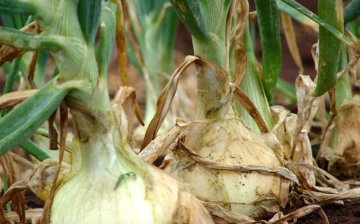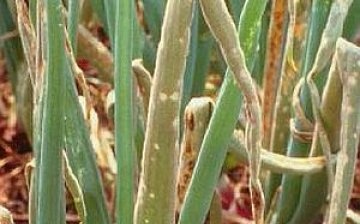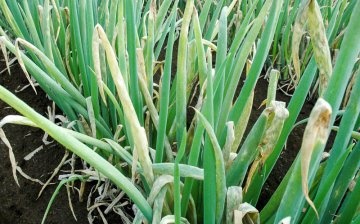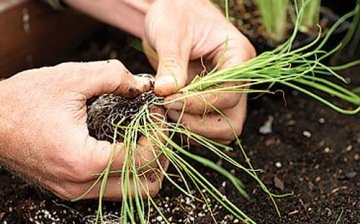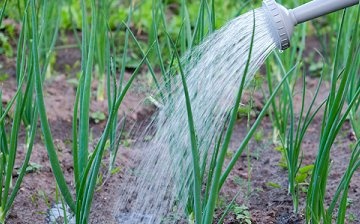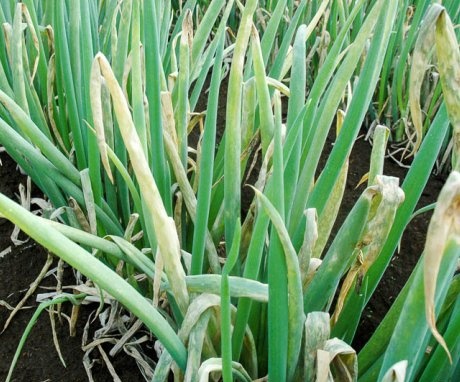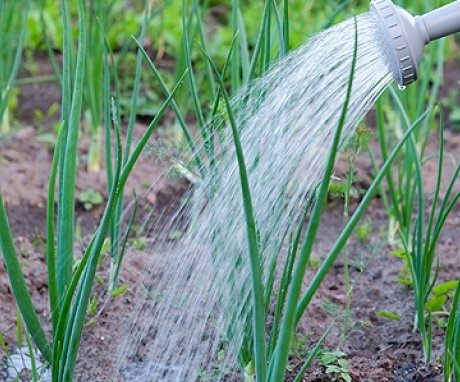Peronosporosis onion: causes of appearance, signs of damage and methods of struggle
Peronosporosis is one of the most harmful diseases onions, it is able to infect all vegetative parts of the plant and lead to seed spoilage. The disease is ubiquitous and can be found in all regions where green onions are grown. Plants can be affected both in the first, and in the second and third years of growth, however, peronosporosis is especially dangerous during the ripening of the testes. For many gardeners, onion peronosporosis is becoming a serious problem, and you need to know how to deal with this disease.
Content:
- Description of onion sporosis
- Causes of occurrence and conditions of development
- Agrotechnical methods of control and prevention
- Chemical and folk methods of struggle
Description of onion sporosis
Another name for peronosporosis is false powdery mildew, the disease received this name because of the gray plaque covering the vegetative parts of the plant. The infection spreads quickly and the infection seed and bulbs in the future can lead to the death of the plant and loss of yield. Externally affected bulbs do not differ from healthy ones, and this makes it difficult to sort the material when planting.
However, already a month after germination disease will begin to develop rapidly.
Signs of bow defeat:
- The first signs begin to appear on green shoots in late April - early May. Yellow spots begin to appear on the peduncles and leaves, and a little later, spores of a gray-purple hue begin to form on them.
- Outwardly, the plant seems to be covered with an unpleasant bloom, it will be especially noticeable in the morning when dew falls.
- Over time, the spots on the leaves continue to grow. Dust sticks to the spores, so the whole plant looks sick, gradually the leaves become brittle.
- The infection penetrates deep into the bulb, and this prevents it from growing to its intended size.
- When the infection enters the peduncles, it interferes with the normal maturation of the seeds.
- Peronosporosis can destroy up to 50% of the crop in the garden if measures are not taken in time.
The fungus is able to overwinter on plant residues after harvesting, as well as on seed. As a result, from year to year, the plants become infected if turnip onions are grown and onion set in the same place.
Causes of occurrence and conditions of development
The main cause of onion peronosporosis is a fungal infection: with a diffuse type of infection, the mycelium begins to grow from the bulb, and the infection gradually spreads along the vascular bundles to all parts and organs of the plant. Under suitable conditions, spores form on all parts of the plant, through which the infection spreads further along the bed.
There is also a local type of peronosporosis: in this case, not the entire plant is affected, but only its individual parts when spores penetrate through the stomata.
Peronosporosis is able to penetrate almost all species of the family: it affects not only the usual onion, but also a batun, chives, leeks, in addition, spores can hit garlic.
In humid years with frequent rains, it develops much more actively, since certain conditions are needed for the growth of mycelium and the maturation of spores:
- High humidity. One of the ways to prevent onion peronosporosis is to plant plants in open areas, well-lit by the sun. Fungus conidia form at night when temperatures drop and humidity rises to 95%.
- Lack of fresh air. If the plants are planted too densely in the garden, and there is not enough space between them, ideal conditions are created for the development of the fungus and the spread of infection.
- Lack of sunlight. If you plant onion in the shade in low places, constant humidity and lack of direct sunlight will lead to the rapid spread of infection. Spores of the fungus are spread by wind and water droplets during rain or heavy watering, a lack of light contributes to the defeat of the leaves.
It has been proven that in hot dry years, onion peronosporosis spreads much more slowly, the development of the fungus can completely stop. But the next year, if the weather is humid enough, you can expect a resumption of infection and its rapid spread.
Agrotechnical methods of control and prevention
Chemical treatment drugs often does not give the desired effect, since the fungus hides in the inner parts of the plant and moves along the vascular bundles. However, agrotechnical methods of stopping peronosporosis will become quite effective, since they create conditions that are unsuitable for the development and reproduction of the fungus.
The following measures will be effective:
- Removing all residues from the garden after harvesting harvest with deep plowing of the soil. In the soil there should be no particles of rhizomes and bulbs on which the fungus can persist. The plowed soil will freeze in autumn, and this will kill the mycelium particles remaining in the soil.
- Compliance with the rules crop rotation... Onions can be planted in one place only at intervals of 3-4 years, this prevents re-infestation during subsequent planting. An additional plus will be cultivation in place of the bow pumpkin, cucumbers and cabbage for several years.
- Isolation of perennial bows from other varieties. Spring onions, shallots and other plants in this family should be located away from annual onions, and they should also be planted in open, well-lit areas.
- Selection of varieties that are resistant to fungal infection. Among them are Antey, Stimul, Rizen, Kasatik and some others. They do not need to be planted often; there should be enough free space between the plants for ventilation.
- Before planting onion sets on a feather, it is recommended to preheat it at a temperature of about 40 degrees, the duration of heating should be at least 8 hours. The increased temperature will kill the spores, but will not damage the bulb's ability to germinate.
Such preventive measures prevent the spread of diseaseseven if the infection has taken place. There are no varieties that are completely resistant to downy mildew onion, but some of them are much more resistant and resistant. It has been noted that varieties that can grow wild are much more resistant to infection.
Chemical and folk methods of struggle
If the plant shows signs of peronosporosis, it is necessary to completely stop feeding. fertilizerscontaining nitrogen, in addition, organic fertilizers cannot be applied, and it is necessary to reduce watering... However, you need to provide the plant with a sufficient amount of potassium and phosphorus fertilizers, it is they who provide a sufficient amount of substances to combat disease.
As a preventive measure, or when detecting the first noticeable spots on the leaves, it is necessary spray plant with Bordeaux liquid, a 1% solution is enough to achieve the effect. An effective remedy against peronosporosis - "Polycarbacin". 40 g of this drug should be diluted in 10 liters of water and sprayed on the plants. You can also use "Arbamid" at a concentration of 30 g per 10 liters. To improve the effect, you can treat the leaves with soapy water to keep the chemical solution on the leaves.
Important! After spraying with Bordeaux liquid or after using Polycarbacin, green onion feathers can no longer be eaten, only bulbs will be suitable.
Chemical agents can be used to combat the fungus no later than 2 weeks before harvest.
Non-native tips:
- Dusting the beds with sifted wood ash will be a safer method of dealing with downy mildew. Enough 50 g of ash per square meter of the garden. It is recommended to repeat the procedure in a week to consolidate the result.
- A safe method of fighting fungus is to use sour whey. Lactic acid bacteria are formed in it, capable of defeating the infection, but at the same time harmless to the plant. To prepare the solution, you can take any spoiled dairy product, separate the whey, dilute it with water and mix until smooth. After that, it is boring to spray the plant with a solution.
The fight against peronosporosis will be successful when several methods are combined. Proper agricultural technology, as well as the use of folk remedies and chemicals will help stop the spread of fungal infection.
More information can be found in the video.



